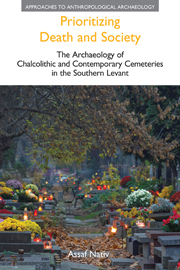 Prioritizing Death and Society
Prioritizing Death and Society Book contents
- Frontmatter
- Dedication
- Contents
- List of figures
- List of tables
- Acknowledgements
- Part I Introduction
- Part II Chalcolithic cemeteries
- 3 Chalcolithic cemeteries: winks, twitches and faked twitches
- 4 Isolated in the landscape: single-cave cemeteries
- 5 Multiple components: multiple-cave cemeteries
- 6 Dark, damp and deep: karstic-cave systems
- 7 Funerary structures
- 8 Exceptions, outliers and misfits
- 9 Structured deposition and depositional structures
- Part III Contemporary cemeteries
- Part IV Conclusion
- Appendix: Gazetteers of cemeteries
- Notes
- Bibliography
- Index
7 - Funerary structures
from Part II - Chalcolithic cemeteries
- Frontmatter
- Dedication
- Contents
- List of figures
- List of tables
- Acknowledgements
- Part I Introduction
- Part II Chalcolithic cemeteries
- 3 Chalcolithic cemeteries: winks, twitches and faked twitches
- 4 Isolated in the landscape: single-cave cemeteries
- 5 Multiple components: multiple-cave cemeteries
- 6 Dark, damp and deep: karstic-cave systems
- 7 Funerary structures
- 8 Exceptions, outliers and misfits
- 9 Structured deposition and depositional structures
- Part III Contemporary cemeteries
- Part IV Conclusion
- Appendix: Gazetteers of cemeteries
- Notes
- Bibliography
- Index
Summary
Unlike other cemeteries of the Chalcolithic period discussed above, the cemeteries that are the subject of this chapter are located above ground. While varying in size, complexity and detail, their position above ground provided them an explicitness of presence that the other burial sites did not have. As a rule, subterranean cavities are indistinguishably embedded within the landscape and practically unnoticeable to those walking above ground. Freestanding structural features, however, can hardly go unnoticed. This appears to suggest a degree of assertiveness that may have facilitated modes of articulation and signalling that were less explicit when caves were in use.
This difference suggests profound implications that may be read in various ways. It may have signalled ownership of land and resources, it may have provided a powerful vehicle to articulate the relationships between the living and their ancestors, or it may have symbolized that the dead were not integrated into the landscape but remained distinct. Whatever one's interpretation, these cemeteries evidently constituted a class of a different order. Our task is to determine whether these differences also crossed over to the cemeteries' structure and dynamics.
Unfortunately, however, the data available for discussion are somewhat limited. To date, only three cemeteries of this kind have been excavated — Palmahim (North), Shiqmim and Nahal Sekher; and of these, only the first two have been published in any detail. Moreover, although excavations followed high standards of conduct, considerable differences in preservation render many strands of data differentially available.
- Type
- Chapter
- Information
- Prioritizing Death and SocietyThe Archaeology of Chalcolithic and Contemporary Cemeteries in the Southern Levant, pp. 88 - 111Publisher: Acumen PublishingPrint publication year: 2013


